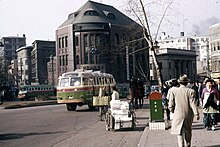Hanil Bank

The Hanil Bank (Korean: 한일은행) was a financial institution first established in Korea under Japanese rule, initially as Chōsen Trust (조선신탁, 1932-1946) then renamed Joseon Trust Bank (조선신탁은행, 1946-1950) and Korea Trust Bank (한국신탁은행, 1950-1954) in South Korea. In 1954, it merged with Korea Trade and Industry Bank (한국상공은행, est. 1936 as Chōsen Central Mujin Company 조선무진[2]) and renamed itself again as Korea Heungup Bank (한국흥업은행), then Hanil Bank in 1960. The latter name alludes to respective names in Korean of Korea and Japan, and has therefore sometimes been rendered in English as Korea–Japan Bank.
It should not be confused with an earlier Korean bank of the same name, active between 1906 and 1931 and a predecessor entity of Chohung Bank.[3]: 144
Under Japanese rule
[edit]Chōsen Trust was created in December 1932 at the initiative of the Governor-General of Chōsen, with initial capital provided by the Bank of Chōsen and the Chōsen Industrial Bank (30 percent each) as well as Dong-il Bank, Honam Bank, and several individual Japanese and Korean businesspeople.
In South Korea
[edit]With the division of Korea, as with other banks previously controlled by Japanese interests, the respective operations of Chōsen Trust were taken over by public authorities on both sides of the 38th parallel. In North Korea, they were soon merged into the central bank within the country's monobank system.[4]
In South Korea, the renamed Korea Heungup Bank was privatized in 1958 and acquired by Samsung C&T Corporation.[2] Like other Korean commercial banks, however, it was nationalized in 1962 following the May 16 coup, as the military government expropriated large shareholders on the premise that their wealth had been amassed illicitly.[5]: 43
In 1981, Hanil Bank was again privatized.[6]: 161 Its privatization was part of a limited financial liberalization effort undertaken by then-president Chun Doo-hwan.[7]: 13 Hanil Bank was chosen because it was deemed the best-managed of the four major commercial banks under government ownership (the others being Chohung Bank, Korea First Bank, and Seoul Trust Bank), and thus the one with the most promising prospects for rapid privatization. The government divestiture was announced in April 1981 and completed in June.[5]: 57-58
In 1984, Hanil Bank established Hanil Lease and acquired Hanil Securities in 1985. By the mid-1990s, it was one of the five most prominent Korean banks, together with Chohung Bank, Korea Commercial Bank, Korea First Bank, and Seoul Bank.[8]
On 31 July 1999, under financial stress following the 1997 Asian financial crisis, Hanil Bank announced its merger with Korea Commercial Bank, with simultaneous public recapitalization that resulted in the government holding a 95-percent equity stake in the merged entity.[9]: 35 The merger was completed in 1999. The merged entity, initially called Hanvit Bank (sometimes transcribed as Hanbit), was renamed to Woori Bank in 2002.
The Hanil Bank head office building was located on Namdaemunro, between the respective former seats of Korea Commercial Bank and Korea Industrial Bank (later Korea Development Bank). It was reconstructed in the late 1970s and eventually sold in 2002 to the Lotte Group which used it for an extension of the central Lotte Department Store, branded as AvenueL.[citation needed]
See also
[edit]References
[edit]- ^ "한국은행 주차장이 된 야스다은행 경성지점". earthwow.org. 25 September 2022.
- ^ a b 신민호 (17 November 2021). "[은행의 뿌리를 찾아서①] 122년을 버텨온 거목, 우리은행". m.g-enews.com.
- ^ Howard Kahm (2012), Colonial Finance: Daiichi Bank and the Bank of Chosen in Late Nineteenth and Early Twentieth Century Korea, Japan, and Manchuria, University of California Los Angeles
- ^ "Banks in N. Korea". KBS World. 3 October 2019.
- ^ a b Byung-sun Choi (1991), "The Politics of Financial Control and Reform in Korea" (PDF), Korean Journal of Policy Studies (6): 41–73
- ^ In Chul Kim, Mahn-Kee Kim, & William W. Boyer (January 1994), "Privatization of South Korea's Public Enterprises", Journal of Developing Areas (28:2): 157–166
{{citation}}: CS1 maint: multiple names: authors list (link) - ^ Yoon Je Cho (November 2002), Financial Repression, Liberalization, Crisis and Restructuring: Lessons of Korea's Financial Sector Policies (PDF), ADB Institute
- ^ Suh Kyoung-ho (21 February 2023). "Profit vs. public obligations". Korea JoongAng Daily.
- ^ Tomás J. T. Baliño & Angel Ubide (1 March 1999), The Korean Financial Crisis of 1997—A Strategy of Financial Sector Reform, Washington DC: The Korean Financial Crisis of 1997
